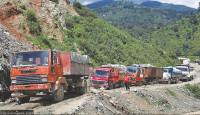Opinion
That’s all there is
Our planet earth is separated into two physical divisions: land and water. Owing to the countless properties of the earth and infinite human intellect, the light of human civilisation has illuminated the future of potential development.
Durga Keshar Khanal
Our planet earth is separated into two physical divisions: land and water. Owing to the countless properties of the earth and infinite human intellect, the light of human civilisation has illuminated the future of potential development. The earth is home to all human beings, wild animals, birds, fish, worms and countless known and unknown creatures. There are also countless species of plants good for both human consumption and development. The earth is also a vast store of several invaluable deposits of minerals. In our solar system, the earth is a haven for both flora and fauna. Therefore, it is called the green planet, the only one in the system.
Learn from history
The green cover of the land which we know as forests is the lifeline of nature. If we destroy or uncover it, there will be a devastating imbalance in the natural order of our environment. The eco-system will eventually disappear. Drought and desertification will make life miserable everywhere. Moreover, uneven rainfall, flood, famine and starvation will prevail. This heaven will consequently turn into hell. The history of human movement and migration with the aim of gaining mastery over the natural resources all over our green planet should serve as a warning to the new generation. Let us think about the past 400 years of Africa’s colonial history and what happened during that period. An impenetrable continent was turned into a desert. Today’s inhabitants in any part of Africa will hardly believe you if you tried to explain the natural history of the continent before the European invasion.
It was the same in the Americas. Another example is South Asia. Once renowned as the golden bow of the earth, South Asia is now known for poverty, misery, famine and starvation. This part of the continent suffers sometimes from drought, and sometimes from heavy rainfall and floods. All this is the result of uncontrolled population growth, expansion of human settlements, growth and movement of domestic animals and pets, and merciless deforestation.
With a distinct geophysical position along the Himalayan range, Nepal should be more concerned about the spreading environmental deterioration. It is equally important to understand the fragile Himalayan morphology. Not only students of geography and environment science, but also geo-physicists, planners and development partners should understand the essence of the subject matter. Only then will they realise the mistakes that have been repeatedly committed.
Serious problems
Nepal’s serious environmental state is shown by the decreasing snow above the snowline in the Himalaya, growing brown spots in place of snow caps, disappearing alpine forests below the snowline, disappearance of green and dark forests in the north and south of the Mahabharata range, widespread landslides and barren terraces, dry stream beds, flood devastated rivers banks, disappearing streams and shrinking water-level in the rivers and uncontrolled, unplanned and unwise expansion of human settlements, villages and towns everywhere. If you travel by aeroplane from one end of the country to the other, from Mechi to Mahakali, you will see clearly all the above-mentioned landscapes.
Nearly two decades ago, a group of geo-scientists and Nobel prize laureates had informed His Majesty’s Government at that time about the degrading environment of the Himalayan country and the possibility of a natural calamity occurring. The document they submitted to the government urged it to initiate the necessary steps to save the Himalayan environment and prevent forces from destroying its natural shield. The document also included some images of the deformed Himalayan landscapes received from NASA. Nepal contains within its small territory all the climates, qualities and diversities found across the entire subcontinent. Some people think that Nepal will look like Switzerland if we develop it. But Switzerland is not only smaller than Nepal, it is also somehow different. Besides physical diversity, Nepal has more natural resources. Why then is our country one of the most backward and poorest in the world? A few issues that have always been neglected but are essential for development can be highlighted. Nepal is perhaps the only country in the world which has not classified its land. No land or territory has been identified for a special purpose except for some national parks.
Planned development was introduced in Nepal only after 1951. There are two systems of planning now—one-year plans in the form of the annual budget and five-year plans aimed at fiscal growth and production. But no plan has contained concepts and schemes of land classification and utility. This manner of running the state without vision has raised the spectre of collapse for the new generation. Above all, the human factor will be the biggest hurdle to conservation planning. Conservation planning will not be successful without the following infrastructure schemes—watershed and soil conservation, safety and revival of wetlands, restoration of disappeared eco-systems, landscape planning and biodiversity, and an integrated scheme for the revival of bio and micro-bio species with a friendly ecosystem.
Population growth in the underdeveloped and developing countries will always be a threat to peace in the world. The time does not look far when our earth will become unable to keep and feed all the people. Food and drinking water have already become scarce. At the same time, the earth is suffering from global warming and climate change. Global warming and climate change threaten to disrupt farm production and drinking water sources. This is mainly because of our failure to keep human society in balance with nature. We must learn to live in harmony with nature. The greatest task that stands before mankind today is controlling population and enriching the natural heritage on a global scale. If we succeed in managing them effectively, we will be able to regain our beautiful environment, limit the expansion of global warming, alleviate the effects of climate change and find a solution to the drinking water crisis.
Khanal is a former Member of Parliament




 24.12°C Kathmandu
24.12°C Kathmandu










